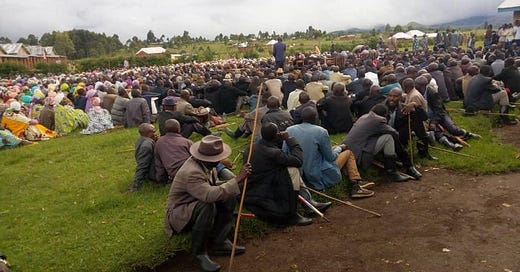Dehumanization Watch: Democratic Republic of the Congo
Dehumanizing rhetoric signals a pre-genocidal situation in the DCR
The photograph above shows a group of Tutsi in the South Kivu district of the Democratic Republic of the Congo. They are paying their respects to two Tutsi women and one Tutsi man who were murdered by decapitation.
There has been an alarming uptick calls for violence, and acts of lethal violence, against the Banyamulenge, a Tutsi community in the Democratic Republic of Congo.The following audio clip, released by the Aegis Trust last month, is one example of incitement to violence against the “Munyarwanda” (Tutsi) community in the DRC.
If you listen, you will hear dangerous, dehumanizing speech. Tutsis are characterized as cockroaches and viruses, and their annihilation is represented as an act of cleansing, of purification. These words are a red flag to anyone with even a nodding acquaintance with exterminationist propaganda.
Felix Mukwiza Ndahinda and Aggée Shyaka Mugabe provide greater detail in their recent article “Streaming hate: exploring the harm of anti-Banyamulenge and anti-Tutsi hate speech on Congolese social media.” They write that:
Other messages, evocative of the genocidal propaganda in Rwanda, contain inflammatory, derogatory, or dehumanizing references to the Banyamulenge/Tutsi: ‘kicking you out of Congo is a cause we are ready to die for. You Tutsi Devils!’; ‘Tutsi vipers’; ‘Tutsi Rwandans are the virus of Congo’; ‘these Tutsi vampires will never be forgiven’; ‘you Rwandans are the ancestors of snakes.’
They also report that another, similar audio broadcast announced:
The Banyamulenge are not Congolese….Don’t show them any mercy! The Inkotanyi [ruling political party in Rwanda] are devils! They are sorcerers! Hit them hard! Pick a machete and kill a Tutsi. Kill all Banyamulenge Tutsis! Use machetes and kill them all, so that we can claim the land of our ancestors back! No single Tutsi shall remain in Congo! Kill a Tutsi, kill a Tutsi!
Ndahinda and Mugabe explain that these dehumanizing tropes are part of an overarching narrative with four core components:
1. Tutsi are parasites, foreigners who exploit the generosity of true (“native”) Congolese people. “Portrayed as ungrateful immigrants who took advantage of the ‘generous/legendary hospitality’ of the ‘natives,’” they write, “the Banyamulenge and Tutsi are denounced for harboring ambitions to conquer Congolese lands, control resources, replace autochthonous leaders, and rule over local communities.”
2. Tutsi do not merely aim to dominate Congo, they are already doing so. “Central… is the claim that Congo is currently under alien Banyamulenge/Tutsi/Rwandan political and military occupation…President Tshisekedi is portrayed as a puppet of the occupants….The very essence of the Combattants’ action is directed at ‘liberating’ the country from that foreign occupation including through violent means….”
3. Tutsi are violent criminals. Exterminating them is an act of self-defense. “Narratives on the criminality of the Banyamulenge…carry justifications for violence against them. Multiple examined materials contained express calls to kill or physically harm the Banyamulenge/Tutsi as in: ‘people of South Kivu, if you cross Tutsi on your way, kill them, it is called self-defence;’ ‘all Tutsi Rwandans in Congo must be killed;’ or, in a comment reminiscent of lynching episodes in Kinshasa in 1998, ‘you Tutsi, we will soon be setting you on fire.’”
4. Tutsi are evil deceivers, with a hidden agenda. “Books such as Lies of the Tutsi, or Stratégie du chaos et du mensonge are evocative of…anti-Tutsi propaganda in Rwanda. They are intended to provide an academic imprimatur to conspiracy theories on the inherent evilness of the Banyamulenge/Tutsi. Kapapi [author of Lies of the Tutsi] vows to demonstrate ‘how lies, conspiracy, murder, extortion, expropriation, manipulation, abuse of power, and taking justice into their own hands are the fundamental cornerstones of the Tutsi in keeping local tribes in the state of colonization.’ The content of these books is popularized in videos posted on digital platforms.”
These kinds of narratives are often associated with exterminationist violence. They are reminiscent of anti-Tutsi propaganda leading up to the 1994 Rwanda genocide,the Protocols of the Elders of Zion, Nazi anti-Semitic rhetoric, violence against the Rohingya in Myanmar, anti-Muslim hate speech in today’s India, and even the neo-Nazi “great replacement” theory that is increasingly popular among Republicans in the US.
As is virtually always the case in this very dangerous variety of dehumanization, marginalized people are not merely thought of as dangerous or disgusting subhuman organisms, but as monstrous entities, embodiments of evil that are endowed with superhuman powers. Tutsi are not only viruses, cockroaches, and snakes in the eyes of their persecutors.They are also vampires, sorcerers, and devils.
To account for what’s going on in cases like this, it’s necessary to look deeply into how the human mind transmutes human beings into monsters. Illuminating this process and tracing out its dire consequences is one of the main tasks that I undertake in this newsletter.




